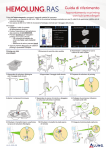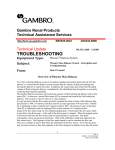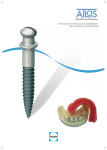Download Clotted access needle Section 12: Troubleshooting Guide
Transcript
Section 12: Troubleshooting Guide • Clotted access needle • Clotted fistula or graft • Bleeding around the needle entry point • Trouble placing your needles • Needle problems while on hemodialysis • Returning your blood when the venous return needle has “blown” • Returning your blood when the arterial return needle has “blown” • Unusual bleeding at the end of a run • Poor flow from a catheter • Clotted catheter • Circulating your blood while on hemodialysis • Fever and chills while on hemodialysis • Chest pain • Hemolysis Clotted access needle Problem: No flow or poor flow from your access needle. Cause: If you have trouble placing your needle a blood clot may form in the needle. Solution: • Try to clear the blood clot from the needle by pulling back on the syringe plunger. • Clamp off your needle and add a new 10mL syringe. • Look for blood clots in your first syringe by squirting the blood onto a gauze pad. • Never push blood into your body that might be clotted • If you are able to remove the clot, flush your needle in and out and then add 10mL pre filled saline syringe to the needle and instill saline to prevent needle from clotting. • If you are not able to fix the needle, remove and place a new “wet” needle i.e. a needle primed to the tip with saline INDEPENDENT DIALYSIS PATIENT WORKBOOK 1 Troubleshooting Guide Clotted fistula or graft Problem: You are unable to feel a thrill or a buzz over your graft or fistula and you cannot hear a bruit. Cause: Wearing tight fitting clothing, jewelry or carrying handbags or grocery bags over your graft or fistula arm might reduce the blood flow in your access. Taking blood work or blood pressure readings on your fistula or graft arm. Coming off dialysis too dry with a low blood pressure or taking off too much fluid too quickly. Solution: • Call your nurse or kidney doctor right away. • You will be asked to go to the emergency room as soon as possible. It might be possible to declot the access. Bleeding around the needle entry point Problem: Fresh blood is oozing from your needle entry site and will not stop. Cause: Using the same needle site over and over in a graft can weaken the graft wall or can tear too large a hole in the graft fabric causing blood to leak out. Using sharp needles in a well formed fistula buttonhole site can tear too large a hole in the vessel wall causing blood to leak out. Solution: • Lower the blood pump speed to 200mL/min. • Place a 2x2 gauze pad under the leaking needle. • Place a 2x2 gauze pad over the leaking needle and press very lightly for five minutes. • If the blood loss does not stop or slow down, you will have to end your treatment and rinseback in the usual way or circle your blood. (See Circulating on Page 7.) 2 BC PROVINCIAL RENAL AGENCY Troubleshooting Guide Trouble placing your needles Problem: Pain and swelling or a lump at needle site when placing needles. Cause: Needle infiltration. This means the needle has accidentally poked through the wall of your fistula or graft. We call this a blown needle. Blood leaking into the area around your fistula or graft causes the swelling and pressure which is painful. You cannot use this needle site for dialysis. Solution: • Take out the needle and apply gauze pad to stop the bleeding. • Place a small ice pack over the swollen area to help reduce any swelling and bruising. • Wait for the bleeding to stop. • If you have a “spare” buttonhole site, use this instead and rest the “blown” site until the swelling and bruising are gone. • If you do not have a “spare” buttonhole you may be able to place a new needle just above or to the side of your buttonhole tunnel. • Patients with a graft and those patients who do not use the buttonhole technique will need to find a new site away from the blown site. If you do not feel able to place another needle, you can delay your treatment until the next day. However, you should first consider the following: • Is it safe to miss this run? • When did you last dialyze? If you are not sure what to do, call your nurse for advice. Needle problems while on hemodialysis Problem: Pain and swelling or a lump near the needle site during the run. Cause: Your needle tip has accidentally poked through the wall of your fistula or graft when you moved your arm. Blood is now leaking into the area around your fistula or graft. Solution: Return your blood using the good needle. (See following page.) INDEPENDENT DIALYSIS PATIENT WORKBOOK 3 Troubleshooting Guide Returning your blood when the venous return needle has “blown” • Stop the blood pump. • Place clean drape under your access limb. • Close the clamp on both your arterial and venous bloodlines and on both needles. • Place an extra safety clamp on the saline infusion port. • Carefully disconnect the clamped saline infusion line and add a sterile recirculation connector to the end to the end of your saline infusion line. • Disconnect your arterial bloodline from your arterial needle. • Attach your arterial bloodline to the saline infusion line using the recirculation connector. • Disconnect your venous bloodline from your blown venous needle. • Attach the venous bloodline to your good arterial needle. • Open the clamp on the saline infusion line. • Open the clamps on the arterial and venous bloodlines and at the arterial needle. • Set the blood pump speed to 150mL/min. • Turn on the blood pump and return your blood through the arterial needle. • Once you have safely returned the blood, take out the blown needle and apply gauze. • Place a small ice pack over the swollen area to help reduce any swelling or bruising. • Wait for the bleeding to stop. • Take out the second needle as usual. • Plan to rest your fistula or graft for one day. • To let machine know treatment has ended, lower time remaining in Time Box to zero. The machine will alarm “treatment time expired.” Press flashing Time button until light goes out. • Press Rinseback button until light comes on. Note: Let your nurse know if you are unable to return your blood. Losing a circuit of blood will lower your hemoglobin for a few weeks and may make you feel weaker or more tired than usual. 4 BC PROVINCIAL RENAL AGENCY Troubleshooting Guide Returning your blood when the arterial return needle has “blown” The steps are the same as for open take off procedure without flushing the blown arterial needle. • Stop the blood pump. • Place clean drape under your access limb. • Close the clamp on both your arterial and venous bloodlines and on both needles. • Place an extra safety clamp on the saline infusion port. • Carefully disconnect the clamped saline infusion line and add a sterile recirculation connector to the end to the end of your saline infusion line. • Disconnect your arterial bloodline from your arterial needle. • Attach your arterial bloodline to the saline infusion line using the recirculation connector. • Open the clamp on the saline infusion line. • Open the clamp on the arterial line. • Set the blood pump speed to 150mL/min. • Turn on the blood pump and return your blood through the venous needle. • Once you have safely returned the blood, take out the blown needle and apply a gauze pad. • Place a small ice pack over the swollen area to help reduce any swelling or bruising. • Wait for the bleeding to stop. • Take out the second needle as usual. • Plan to rest your fistula or graft for one day. • To let machine know treatment has ended lower time remaining in Time Box to zero. The machine will alarm “treatment time expired” press flashing Time button until light goes out. • Press Rinseback button until light comes on. Note: Let your nurse know if you are unable to return your blood. Losing a circuit of blood will lower your hemoglobin for a few weeks and may make you feel weaker or more tired than usual. INDEPENDENT DIALYSIS PATIENT WORKBOOK 5 Troubleshooting Guide Unusual bleeding at the end of a run Problem: It is taking too long for the needle sites to stop bleeding (more than 15 minutes). Cause: You may be using too much heparin. You may be taking off your dressings too soon or too roughly which can dislodge your scab and cause bleeding to start again. You may have a narrowing (stenosis) in your fistula or graft which causes increased pressure inside your access. Solution: • Try using less heparin. Call your nurse to lower your running dose. • Leave your dressings on for four hours or overnight before carefully removing them. • Always track your venous and arterial pressure readings at 200mL/min at the beginning of your run. Note: If the venous pressure VP has become higher or if the arterial pressure AP has become more positive. Let your nurse know. You may need a fistulogram to check for a narrowing or stenosis. Poor flow from a catheter Problem: Poor blood flow from the catheter at hook up or during treatment Cause: A blood clot or fibrin sheath may have formed into a flap over the tip of the catheter The catheter might have moved slightly. Solution: • Try coughing deeply. This causes increased pressure in your chest cavity and might help to shift the flap at the tip of the catheter. • Try changing your position. Move from side to side. Lower your head. • If you have a good flow from only one port, use this as your arterial outflow. You may be able to return through the other port. This may mean you have to run with your lines in reverse position. • Call your nurse or kidney doctor. You may need to instill a medication called TPA/Cathflo into your catheter. TPA/Cathflo helps to dissolve blood clots and fibrin sheaths. 6 BC PROVINCIAL RENAL AGENCY Troubleshooting Guide Clotted catheter Problem: You cannot remove the block (sodium citrate or heparin) from one or both limbs of your catheter. Cause: Your catheter might be clotted or it might have moved slightly. Solution: • Try coughing deeply. This causes increased pressure in your chest cavity and might help to dislodge a blood clot at the tip of the catheter. • Try changing your position. Move from side to side. Lower your head. • Call your nurse or kidney doctor. You may need to instill a medication called TPA/Cathflo into your catheter. TPA/Cathflo helps to dissolve blood clots and fibrin sheaths. • If TPA does not help the doctor will need to order a linogram to check the position of the catheter. The catheter may need to be changed at this time. Circulating your blood while on hemodialysis If you have needle problems or if you have excess air in the blood circuit you may be able to circulate your blood. Your blood can safely circulate for up to 30 minutes. This will give you time to safely remove any air or remove and replace a blown, clotted or leaking needle Note: Always have 2x10mL prefilled saline syringes and a sterile recirculation connector ready on the top of your machine in case you need to circulate your blood whilst on hemodialysis. How to circulate your blood • Place clean drape under your access • Stop blood pump • Clamp the arterial and venous blood lines • Clamp the arterial and venous access lines. • Carefully separate the arterial bloodline from the arterial access line and attach a 10mL prefilled saline syringe to the arterial access line. • Attach a sterile recirculation connector to the arterial blood line. • Carefully separate the venous bloodline from the venous access line and attach a 10mL prefilled saline syringe to the venous access line. • Attach the venous bloodline to the other end of the sterile recirculation connector. INDEPENDENT DIALYSIS PATIENT WORKBOOK 7 Troubleshooting Guide • Open clamps on bloodlines and access lines (4 clamps) • Open clamps on saline infusion line and saline infusion port(2 clamps) • Lower blood flow rate to 100mL/min • Restart blood pump • Press the START UF STOP button (it flashes] to minimize fluid removal For more information, see Circulating in Section 8, page 9 of the AK 955 Training Guide Fever and chills while on hemodialysis A very small rise in your body temperature above normal is usually a sign of infection. Normal body temperature is about 36.5 degrees Celsius or 98 – 99 degrees Fahrenheit. In many cases your dialysis access will be the site of the infection. Infection can also be caused by contaminated water or dialysate or by improper technique when setting up your machine. If you have a fever or suspect your dialysis access might be infected, call your dialysis nurse or doctor before starting dialysis. If you do have an infection, you may experience some or all of the following symptoms: • A chill after you start dialysis, which may cause you to start shaking uncontrollably (rigors) • A higher than normal temperature (fever) • An unusually low blood pressure • Headache • Aching muscles • Nausea and vomiting If you experience some or all of these symptoms, take the following actions: • Come off dialysis as you may start to feel too unwell to manage your dialysis safely. • Check your dialysis access for signs of infection, e.g. redness, heat, pain, swelling or drainage. • Take your temperature. • Check for other signs of infection, e.g. coughing up thick coloured sputum or pain when passing urine. • Call your training nurse or physician for advice. 8 BC PROVINCIAL RENAL AGENCY ! Troubleshooting Guide • Be prepared to go immediately to your local training site or emergency room. If you feel very unwell and cannot contact your dialysis team, go to your nearest hospital emergency room. Remember to take all your medications with you when you go to the ER. • At hospital you will probably be put onto IV antibiotics. Chest pain Signs and symptoms may include: pain or tightness in chest, back, arms, or jaw; difficulty breathing; shortness of breath; anxiety; weakness; severe indigestion. What to do if you are not on dialysis • Call 911 • Bring your medications or medication list with you to the ER. What to do if you are on dialysis • Remain calm, but act immediately • Call 911 • Return blood – if no air in blood • Lower head • Take blood pressure – if your B/P is low, give 200mL extra saline. Repeat three times as needed • If you have been prescribed nitroglycerin, take one pill/spray every 5 minutes for up to 3 doses • Wait for paramedics to arrive before removing dialysis needles • Bring your medications or medication list with you to the ER Possible causes of chest pain • Fluid overload (hypervolemia) • Going below your goal weight (hypovolemia) • Low hemoglobin (anemia) • Not enough oxygen to heart (hypoxemia) • Heart disease (CAD) • Hemolysis • Dialyzer reactions • Air in your bloodstream INDEPENDENT DIALYSIS PATIENT WORKBOOK 9 Troubleshooting Guide Hemolysis Hemolysis is the word used to describe the lysis (break up) of red blood cells resulting in the release of potassium What can cause hemolysis in a hemodialysis patient? • Your dialysis fluid temperature is too hot. • Your dialysis fluid is too dilute. • Chemical disinfectant has not been properly rinsed from the machine. • Your blood pump is damaged and “pinching” the bloodline. • Your bloodline is kinked during the dialysis run Note: Always check your lines for any kinking in particular after flipping your dialyser during priming) What are the signs and symptoms of hemolysis? Your blood may appear transparent and “cherry pop” red in colour. You may experience any of the following symptoms and these can occur several hours after your dialysis: • Sudden onset of shortness of breath. • Sudden onset of chest pain. • Severe lower back pain • Nausea and Vomiting • Diarrhea What do I do if I suspect hemolysis? • Stop blood pump immediately. • DO NOT RETURN ANY OF YOUR BLOOD. • If you have chest pain or shortness of breath dial 911 for an ambulance to take you to the ER. • Call your nurse or doctor on call immediately. • Save your dialysis blood lines, dialysate jug and bicart (arrange for them to be brought to the hospital with you). 10 BC PROVINCIAL RENAL AGENCY





















